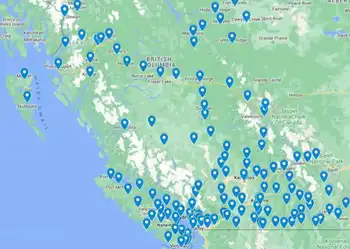$2.5B Shell Scotford Project Hits Stride
Gateway To North America's Electrical Industry -
Edmonton, AB. -- Shell Canada's industrial site at Scotford will take on 5,000 trades workers and 81 cranes next month as the company's $2.5-billion expansion project hits its peak construction period.
"It's a continuous challenge," said Shell Scotford general manager Sam Spanglet. "But we are on time and on budget."
Shell's refinery complex at Scotford, 50 km northeast of Edmonton, will more than double in size by the time the project is completed in late 2002.
The company is pouring $400 million into refinery modifications so it can handle heavier grades of crude oil. Another $1.8 billion is being spent by Shell and minority partners Chevron Canada and Western Oil Sands to build an upgrader to feed the refinery.
The upgrader will have two 1,400-tonne reactors, Spanglet said. To get them erect, Shell will need to hire the largest cranes in the world.
The steel going into the site will exceed the combined tonnage used in Shell's three existing Canadian refineries.
Atco Power will also build a 150-megawatt power plant to serve the site. The upgrader will use about 80 per cent of the plant's electricity, plus steam.
All these ventures are part of a larger suite totalling nearly $5 billion, including a $1.8-billion Muskeg River mine 70 km north of Fort McMurray, and a $600-million, 450-km Corridor pipeline system to connect Muskeg and Scotford.
The logistics of such a system are daunting. The pipelines -- one large line to carry oil south and a parallel pipe to return diluting agents -- are about half-done.
The refinery modifications at Scotford will be complete in December of this year. In May, Shell will have a 30-day shutdown to tie the new refinery equipment to existing trains.
The upgrader has two production units as well. The first is to be ready to operate in the fall of 2002, and the second is to start up three months later, both in time for the mine's production of 155,000 barrels per day.
The expansion has increased tensions with some neighbours, Spanglet noted. Twenty-two of 24 residents west of the Shell site have been offered buyout packages by Strathcona County. Now a few homeowners east of Shell, towards Bruderheim, are also voicing concerns.
Related News

BC’s Electric Highway
VANCOUVER - British Columbia has taken a significant step toward sustainable transportation with the completion of its Electric Highway, a comprehensive network of electric vehicle (EV) charging stations strategically placed across the province. This ambitious project not only supports the growing number of EV owners but also plays a crucial role in the province’s efforts to combat climate change and promote clean energy.
The Electric Highway spans from the southern reaches of the province to its northern edges, connecting key urban centers and remote communities alike. With over 1,400 charging stations installed at various locations, the network is designed to…




